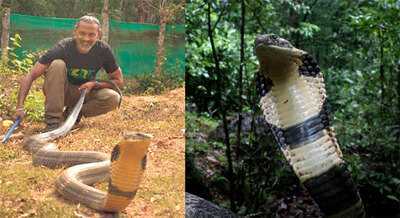
The world’s longest venomous snake, the King Cobra, is now officially under consideration to be included in the IUCN Red List of Endangered Species, marking a significant step toward its protection. Recognizing the alarming threats to the species, international wildlife experts are moving to reclassify the King Cobra from the “Vulnerable” category to “Endangered”.
This global concern has put the spotlight on Agumbe, the rainforest region in Karnataka often called the “King Cobra capital of the world”. The conservation and research efforts here, led by Dr. P. Gowri Shankar and his team at the Kalinga Centre for Rainforest Ecology, are now becoming a model for King Cobra preservation internationally – particularly for the Philippines.
Agumbe’s Contribution to Conservation
Over the past two decades, Dr. Gowri Shankar’s team has studied over 500 individual King Cobras and more than 50 nests. Their work has documented the snake’s geographical spread and key differences in physical traits across regions, leading to the identification of four subspecies: Northern King Cobra, Sunda King Cobra, Western Ghats King Cobra, and Luzon King Cobra.
Agumbe’s dense forests and humid climate provide an ideal habitat, making it the world’s most significant natural stronghold for King Cobras. Conservationists here are using radio telemetry to track and study snake behavior — a first-of-its-kind effort in India.
Why the King Cobra is at Risk?
The species is under growing threat due to deforestation, habitat encroachment, hunting for skin and meat, and urban expansion. The IUCN (International Union for Conservation of Nature) is now moving the species into the “Endangered” category based on increasing data of declining populations and habitat fragmentation.
In countries like Indonesia and the Philippines, King Cobras are still killed out of fear or hunted commercially, worsening the threat. In the Philippines, forest encroachments for commercial farming had pushed local populations of the species near extinction.
Philippines to Follow Agumbe’s Model
Inspired by the success of Agumbe’s conservation efforts, the Philippines government has decided to adapt similar methods to protect its native Luzon King Cobra population. Dr. Gowri Shankar is providing advisory support, and the study methods — including community participation, radio telemetry, and habitat protection — are being adopted there as part of new policy initiatives.
What is IUCN Red List?
The IUCN Red List evaluates species based on scientific data regarding population, habitat, and threats. It categorizes species under nine threat levels including Critically Endangered, Endangered, Vulnerable, and Least Concern, helping governments and conservation bodies prioritize action.
Urgent Need for Anti-Venom Solutions
Currently, India’s healthcare system provides anti-venom for only four types of snakes, excluding King Cobras. “The government must ensure that anti-venom treatment for King Cobra bites is made available, especially in rural hospitals,” urged Dr. Gowri Shankar.
As the King Cobra faces growing dangers, Agumbe’s fieldwork stands as a global beacon for snake conservation — combining science, tradition, and grassroots action in preserving one of nature’s most majestic reptiles.